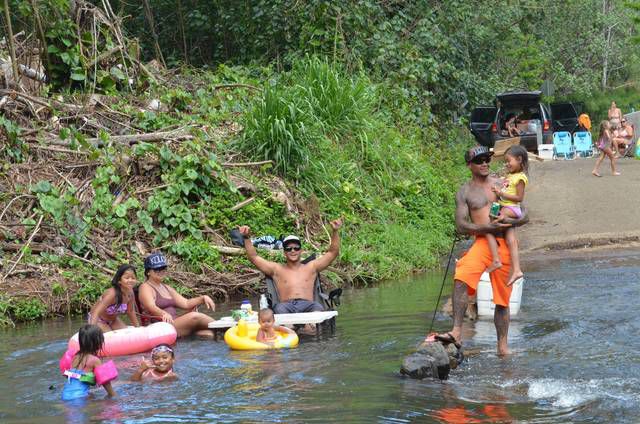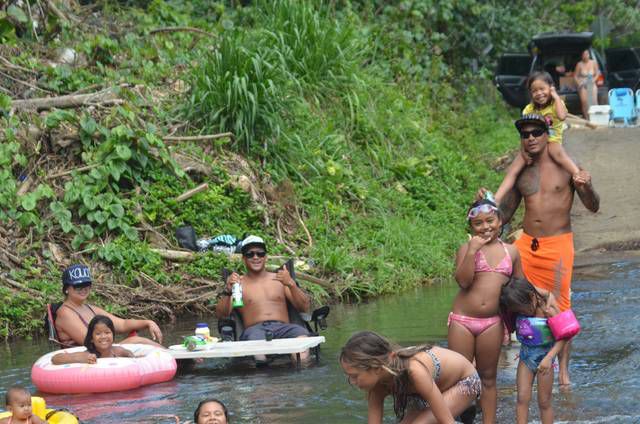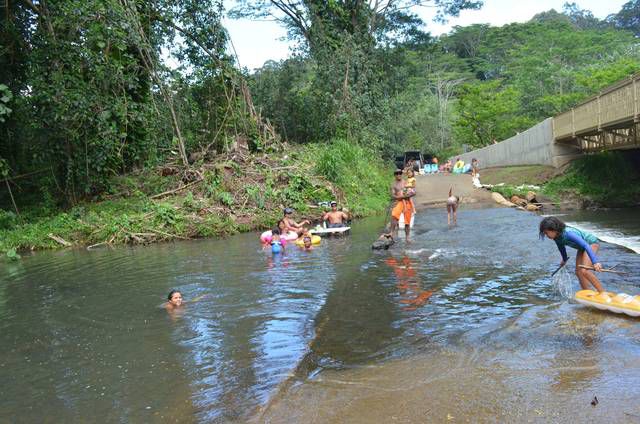WAILUA — Vehicles are now using the new steel bridge over Keahua Stream on “Loop Road” — and a few people have found it creates an advantage for them. For instance, Chico Santiago, Steffanie Papagayo and Keawe Tangalin set up
WAILUA — Vehicles are now using the new steel bridge over Keahua Stream on “Loop Road” — and a few people have found it creates an advantage for them.
For instance, Chico Santiago, Steffanie Papagayo and Keawe Tangalin set up a table and chairs in the middle of Keahua Stream by the old ford Friday and enjoyed the afternoon while the kids played in the river.
“After not coming here for a couple of years, the bridge, it was an eyesore at first,” Santiago said. “But then I saw the kids playing and it is safer because there’s no more traffic.”
Since vehicles are now using the 115-foot-long bridge, which can support up to 20 tons, they aren’t splashing across the ford.
“It keeps it clean, too, from all the oil and mud and all that stuff for the kids,” Tangalin said. “But I am worried about what it’s really for. I don’t know if they built it just for safety.”
Tangalin isn’t alone in that concern — community members questioned the state Department of Land and Natural Resources Division of Forestry and Wildlife on that topic at several community meetings held about the project.
Construction on the bridge started in September. It wasn’t until after they broke ground that the state explained the project in two community meetings, one in November and one the following February.
Meeting attendees voiced concerns about the bridge’s purpose, asking if it will be used for commercial logging in the forest.
Currently DLNR/DOFAW is considering an update to the Lihue-Koloa Forest Reserve Management Plan that would allow for the harvesting of 360 acres of timber in the forest reserve, made up of three species of non-native eucalyptus and paperbark trees.
The trees were planted in the 1930s and again in the 1960s when the Keahua Arboretum started as a demonstration project for exotic timber species.
DLNR representatives say commercial loggers that are set to harvest the non-native lumber in the Lihue-Koloa Forest Reserve wouldn’t use that bridge.
“If logs or wood products come out, they have to go another way. The bridge was built for safety reasons,” Sheri Mann, branch manager for DOFAW, said at the February meeting.
On Friday, Lei‘ana Hooikaika was running in and out of the water under the bridge.
“I like that the bridge goes up, and then it goes down,” she said.
She was one of around 10 kids playing in the water while a handful of adults lounged on the edges of the ford or relaxed in a hammock under the bridge.
“I say come out here and see what it’s like and you might get used to it and enjoy it,” Santiago said.




